When it comes to the corporate world, physical forms continue to be an essential, albeit underappreciated, facet of everyday operations. These indispensable tools serve as conduits, guiding a multitude of work-related transactions, from mundane administrative tasks to crucial decision-making processes.
This article aims to shed light on various types of physical forms used in a work environment, exploring their significance, utility, and the ways in which they streamline our professional lives. Through this exploration, we hope to enhance your understanding of these crucial resources, underlining their pervasive influence on workplace productivity and efficiency.
Table of Contents
What is a Physical Form for Work?

A Physical Form for Work is a tangible document used in professional environments to record, track, and manage various pieces of information related to business operations. These can range from employment applications, tax documents, and time-off requests, to purchase orders, safety inspections, and incident reports, among others.
They play a crucial role in maintaining compliance, ensuring accuracy of information, facilitating communication, and establishing a formal record of decisions or actions taken. While the digital shift has led many organizations to adopt electronic versions of these forms, the physical forms continue to hold relevance in many areas of business.
Physical Form for Work Templates
Physical Forms for Work templates are indispensable tools for any business. As a comprehensive solution, these templates provide structure and standardization to physical work evaluations, documentation, and related procedures.
Streamlining operations becomes simple with these readily printable and customizable forms. Ideal for maintaining records, tracking employee physical capabilities, and ensuring workplace safety, these templates can be a catalyst for efficiency and organization in your business. Easy to use, professionally designed, and free to access, our Physical Forms for Work templates are a perfect blend of convenience and functionality.
Why Is Physical Form for Work Important?
Physical fitness plays a critical role in achieving optimum work performance. While the specific physical demands may vary depending on the type of work (office job, manual labor, healthcare, etc.), maintaining a good physical form is beneficial for all employees. The reasons are manifold, including better stress management, increased energy levels, reduced risk of health issues, improved mental health, and more.
In this detailed guide, I will break down why physical form for work is important, its benefits, and how you can maintain and improve your physical form.
1. Energy Levels and Endurance
Engaging in regular physical activity boosts energy levels. Physical fitness helps improve cardiovascular health, ensuring that your heart and lungs work efficiently. This efficiency translates to more energy to tackle daily tasks. High energy levels are essential in maintaining productivity throughout the workday, particularly in physically demanding jobs.
2. Stress Management
Exercise is known to relieve stress. It promotes the production of endorphins, chemicals in the brain that act as natural painkillers and mood elevators. Regular exercise can help you manage work-related stress, improving overall job satisfaction and reducing the risk of burnout.
3. Reduced Risk of Health Issues
Staying in good physical shape reduces the risk of various health problems such as obesity, diabetes, heart disease, and certain types of cancer. This results in fewer sick days and decreased healthcare costs, which is beneficial for both the employee and the employer.
4. Improved Mental Health
Physical activity has a positive effect on mental health. It can help manage symptoms of depression and anxiety and improve mood. A healthy body leads to a healthy mind, which is crucial for work that requires problem-solving, creativity, or high levels of concentration.
5. Better Cognitive Function
Exercise improves cognitive functions like memory, attention, and processing speed. Regular physical activity enhances brain health by improving blood flow and promoting the growth of new brain cells. Improved cognitive function is beneficial in any work environment.
6. Enhanced Physical Abilities
For jobs that involve manual labor, fitness is a necessity. Strength, flexibility, balance, and coordination – all these can be improved through regular physical activity. These improvements can help prevent workplace accidents and injuries.
7. Improved Sleep
Regular physical activity can improve sleep quality, which is essential for overall health and daily functioning. Good sleep helps with memory consolidation, mood regulation, and physical recovery, all of which are essential for optimal work performance.
8. Boosted Confidence and Self-Esteem
Physical fitness can enhance self-image and self-esteem, which can lead to improved interpersonal relations in the workplace. Confidence can enhance your work performance, making you more likely to take on new challenges and strive for advancement.
Now, how can you maintain and improve your physical form?
1. Regular Exercise
Incorporate physical activities into your daily routine. These could include walking, running, swimming, cycling, or gym workouts. Aim for at least 150 minutes of moderate-intensity aerobic activity or 75 minutes of vigorous-intensity activity per week.
2. Strength Training
Include strength training exercises in your routine at least two days a week. These can help improve muscle strength and endurance, which are particularly important for physically demanding jobs.
3. Healthy Eating
Pair physical activity with a balanced diet. Incorporate a variety of foods in your diet, including fruits, vegetables, lean proteins, whole grains, and healthy fats.
4. Adequate Rest
Rest is crucial for recovery. Ensure you get 7-9 hours of sleep each night. Take short breaks during work to rest and recharge.
5. Regular Health Check-ups
Regular health check-ups can help monitor your health and identify any potential issues early.
6. Mind-body Practices
Engage in mind-body practices like yoga or tai chi. These exercises can enhance flexibility, balance, and stress management.
When Physical Form for Work is Needed
The importance of maintaining good physical form or fitness for work extends to every profession, but the level of fitness required can vary greatly. Some jobs are inherently physically demanding, requiring strength, agility, and endurance, while others are sedentary but still benefit from a good physical condition due to its positive impact on overall health, focus, and productivity. Here’s a detailed explanation on when physical form for work is needed:
1. Physically Demanding Jobs
Jobs that involve heavy labor or physical exertion require workers to be in good physical form. This includes professions like:
- Construction Workers: These individuals often lift heavy materials, operate machinery, and work in physically strenuous positions.
- Emergency First Responders: Police officers, firefighters, and EMTs need to respond quickly to emergencies, which may involve running, lifting, and moving quickly in high-stress situations.
- Military Personnel: Physical fitness is a necessity in the military, where rigorous physical activity is often part of the job.
- Athletes and Trainers: Professional athletes, fitness trainers, and coaches need to maintain peak physical form to perform and teach effectively.
- Warehouse Workers: Jobs that involve lifting and moving heavy boxes or operating manual pallet jacks demand a good level of physical fitness.
- Healthcare Professionals: Nurses, doctors, and other healthcare professionals often work long hours and are on their feet for extended periods. They may also need to assist in lifting or moving patients.
- Farmers and Agricultural Workers: These jobs often involve physical labor like lifting, bending, and using manual or heavy equipment.
2. Active Jobs
Even jobs that are not as physically demanding but involve a lot of movement can benefit from workers being in good physical form. For instance:
- Teachers and Childcare Workers: These professionals are often on their feet and need to keep up with the active pace of children.
- Retail and Food Service Workers: These jobs require standing for long periods, lifting moderately heavy items, and moving quickly during busy times.
3. Sedentary Jobs
Even for desk jobs, maintaining physical fitness is essential for several reasons:
- Productivity and Focus: Regular physical activity can boost cognitive functions, leading to better focus, memory, and productivity.
- Prevent Health Issues: Sedentary lifestyles are linked to a variety of health problems, such as obesity, heart disease, and diabetes. Regular exercise can mitigate these risks.
- Mental Health: Physical activity is beneficial for mental health, helping to manage stress and improve mood, which is important for any work environment.
- Posture: Regular exercise, particularly strength training, can promote better posture, preventing back pain and other musculoskeletal problems often associated with sitting jobs.
- Energy Levels: Exercise can help improve energy levels, counteracting the fatigue often associated with sedentary work.
4. Creative and Cognitive Jobs
While not physically demanding, jobs that require a high level of cognitive or creative thinking can benefit from physical fitness. This includes roles like software developers, writers, designers, engineers, and researchers. Exercise can enhance creativity and problem-solving skills by improving brain health, mood, and sleep.
Key Components of Physical Form for Work
The key components of physical form for work can vary depending on the type of job and its specific demands. However, regardless of profession, there are five general components of physical fitness that can contribute to improved work performance and health. These are:
1. Cardiovascular Endurance
Cardiovascular endurance, also known as aerobic capacity, is the ability of your heart and lungs to supply oxygen to your body during sustained physical activity. This is crucial for physically demanding jobs or jobs that require stamina. Improved cardiovascular endurance can lead to higher energy levels, improved focus, and better overall work performance. Regular cardiovascular exercises such as running, cycling, or swimming can help to improve this component of physical form.
2. Muscular Strength
Muscular strength is the maximum amount of force that a muscle can exert. This is particularly important in jobs that require heavy lifting or repeated forceful movements. However, even in a sedentary job, maintaining muscle strength can help prevent musculoskeletal issues. Resistance and weight training exercises are good ways to build and maintain muscle strength.
3. Muscular Endurance
While muscular strength relates to the amount of force a muscle can exert, muscular endurance refers to the ability of your muscles to perform repeated actions over time without becoming fatigued. This is essential in jobs that require prolonged physical activity or repetitive tasks. Muscular endurance can be improved through exercises like circuit training or bodyweight exercises.
4. Flexibility
Flexibility is the range of motion available in a joint or group of joints. It’s crucial in preventing injury and maintaining a good posture. Flexibility is important for all jobs, including those that are sedentary, as it can help to prevent common issues like back pain and repetitive strain injuries. Stretching exercises and activities like yoga or Pilates can help to improve flexibility.
5. Body Composition
Body composition refers to the ratio of lean body mass (including muscle, bone, organs, and more) to fat mass in the body. Maintaining a healthy body composition is crucial for overall health and can impact your performance at work. High body fat percentages, particularly when associated with obesity, can lead to numerous health problems, including cardiovascular disease and diabetes, which can impact productivity and job performance. Maintaining a healthy diet and a balanced exercise routine can help manage body composition.
In addition to these components, other factors also play a crucial role in physical form for work. These include:
- Posture: Good posture reduces the risk of developing disorders related to the musculoskeletal system and helps you maintain balance, strength, and flexibility.
- Balance and Coordination: Balance is the ability to maintain a particular body posture against gravity, while coordination is the ability to execute smooth and efficient movements. Both are essential in preventing falls and other workplace injuries.
- Resilience: This relates to the body’s ability to recover quickly from illness, injury, or stress. Regular physical activity, adequate sleep, and good nutrition all help improve resilience.
- Ergonomics: This involves adapting the workplace and job demands to the capabilities of the worker, considering factors like the design of workstations, equipment, and workflow to fit the worker’s physical capabilities and limitations.
Types of physical tests done on employees
Workplace physical fitness tests are designed to evaluate an individual’s ability to perform the physical demands of a specific job. These tests can be a part of pre-employment screening, ongoing fitness-for-duty evaluations, or return-to-work assessments after an injury or illness. The type of tests used depends on the nature of the job, its physical demands, and potential hazards. Here, we explore different types of physical tests conducted on employees in detail:
1. Musculoskeletal Screening
Musculoskeletal screening involves a series of tests to assess the integrity of an individual’s musculoskeletal system. These tests may assess muscle strength, joint flexibility, and range of motion. The screening can help identify areas of weakness or stiffness that could impact an individual’s ability to perform specific tasks or potentially lead to injury.
Examples of musculoskeletal screening tests include:
- Strength Tests: These tests evaluate the strength of specific muscle groups. For instance, grip strength tests measure the maximum force exerted by the hand muscles when gripping.
- Flexibility Tests: Flexibility tests assess the range of motion in joints. The sit-and-reach test, which measures the flexibility of the lower back and hamstring muscles, is a common example.
2. Cardiovascular Fitness Tests
Cardiovascular or aerobic fitness tests assess the efficiency of the heart, lungs, and vascular system in delivering oxygen to working muscles during sustained physical activity. Jobs that require significant physical exertion, such as firefighting or law enforcement, often require cardiovascular fitness testing.
Examples of cardiovascular fitness tests include:
- Step Tests: The individual steps up and down on a platform of a specified height at a set speed for a few minutes. The individual’s heart rate is measured to estimate their cardiovascular fitness.
- Treadmill Tests: These tests involve walking or running on a treadmill at increasing speed or incline. Heart rate, blood pressure, and perceived exertion are monitored to assess cardiovascular fitness.
3. Physical Abilities Tests (PATs)
Physical Abilities Tests (PATs) or Physical Capacity Tests (PCTs) measure the ability to perform the physical demands of specific jobs. These tests are often job-specific and designed to simulate actual work tasks. For instance, a firefighter PAT may include dragging a hose, carrying equipment, or climbing stairs while carrying weight.
Examples of tasks in a PAT include:
- Lifting/Carrying Tests: These tests measure the ability to lift and carry weights, simulating tasks like moving equipment or lifting patients.
- Agility Tests: These tests assess the ability to quickly change body position or direction, which may be necessary in jobs like law enforcement or emergency response.
- Balance Tests: Balance tests can be important for jobs that involve working at heights or on uneven surfaces.
- Endurance Tests: These measure the ability to sustain physical activity over time, like continuous lifting or prolonged standing.
4. Functional Capacity Evaluations (FCEs)
A Functional Capacity Evaluation (FCE) is a comprehensive assessment that measures an individual’s ability to perform work-related tasks. This evaluation is often used to determine fitness for work after an injury or illness. An FCE typically involves a physical examination and a series of tests that simulate work tasks.
FCEs can include:
- Simulated Work Tasks: These can range from sitting and standing to more complex tasks like lifting, carrying, bending, reaching, and handling tools.
- Tolerance Tests: These measure the ability to perform tasks over time, assessing endurance.
- Speed and Dexterity Tests: These evaluate the ability to perform tasks quickly and accurately, which can be important in jobs that require precise, rapid hand movements.
5. Pre-employment Physical Exams
Many employers require pre-employment physical exams to ensure that prospective employees are physically capable of performing the job tasks and to establish a baseline for future health evaluations. These exams typically involve a general health check-up, including heart rate, blood pressure, vision, and hearing tests.
In addition to these general tests, pre-employment physical exams might also include:
- Drug and Alcohol Tests: Employers may require prospective employees to undergo drug and alcohol testing as part of the pre-employment physical examination.
- Occupational Health Screenings: These are industry or job-specific screenings that evaluate the individual’s ability to safely perform the specific demands of the job. For example, commercial drivers may undergo a Department of Transportation (DOT) physical exam to ensure they can safely operate a commercial vehicle.
6. Respiratory Fitness Tests
Respiratory fitness tests, such as spirometry, are used to assess lung function. These tests are crucial for jobs that may involve exposure to respiratory hazards, like dust, chemicals, or smoke.
7. Agility and Reaction Time Tests
Agility tests measure the ability to quickly change body position or direction, while reaction time tests evaluate the speed of response to a stimulus. Both types of tests can be important in jobs that require quick reflexes or sudden changes in movement, like athletes, firefighters, or delivery drivers.
8. Postural Assessments
These tests are designed to evaluate an individual’s posture and body alignment, which can impact musculoskeletal health. Jobs that involve prolonged sitting or standing, or repetitive tasks, can lead to postural imbalances that may result in discomfort or injury over time.
9. Vision and Hearing Tests
Vision and hearing tests are essential for many jobs. Good vision is necessary for tasks like reading, while good hearing may be important in environments where verbal communication is key. These tests are particularly important in jobs where impairment of these senses can lead to safety issues, such as driving or operating machinery.
10. Psychological Fitness Tests
While not a physical test per se, psychological fitness can impact physical performance, particularly in high-stress jobs. Some employers may use psychological testing to assess traits like stress tolerance, decision-making ability, and emotional stability.
What is a pre-employment medical form?
A pre-employment medical form is a document used by employers to assess a prospective employee’s physical fitness and ability to perform job-related tasks safely and effectively. The form typically includes questions about the applicant’s medical history, current health status, and lifestyle habits.
Depending on the job’s nature and requirements, it may also request consent for further tests, such as a physical examination, vision or hearing tests, drug and alcohol tests, or other specific tests relevant to the job. The information gathered helps the employer determine if the candidate is medically suitable for the role, identify any potential workplace accommodations that may be needed, and establish a baseline for future health evaluations.
How to Fill Out a Physical Form for Work
Completing a physical form for work involves providing accurate and detailed information about your health. Each form may be slightly different, depending on the employer’s requirements and the specific job role. However, the general steps to fill out a physical form for work are as follows:
1. Personal Information:
At the top of the form, you’ll usually find fields to fill in your personal information. This may include:
- Full Name
- Date of Birth
- Contact Information (phone number, email, address)
Fill in these sections accurately and legibly.
2. Medical History:
This section typically asks about your past medical conditions, surgeries, hospitalizations, allergies, and current medications. Ensure you:
- Provide accurate details about your medical history.
- Specify any chronic illnesses or conditions you have (e.g., diabetes, heart disease, asthma).
- List any allergies, especially drug allergies.
- List any medications you are currently taking, including both prescription and over-the-counter drugs, as well as any supplements.
- Describe any past surgeries or hospitalizations, including the reason and date.
3. Family Medical History:
Some forms may ask for information about the health history of your immediate family (parents, siblings). They may ask about any chronic diseases, such as heart disease, diabetes, or cancer, in your family. This information can be important because some conditions have a genetic component.
4. Lifestyle Information:
This part of the form typically asks about lifestyle habits that can impact health, such as smoking, alcohol use, diet, and exercise. Be honest about your habits as these can impact your health and your ability to perform certain job duties.
5. Work History:
Some forms may require information about your previous work experiences, especially those related to the job you’re applying for. They may ask about any injuries or health problems you’ve had in past jobs.
6. Physical Examination:
This is typically filled out by the healthcare provider performing the physical exam. It may include:
- Vital signs (blood pressure, heart rate, temperature, respiratory rate)
- Vision and hearing tests
- Evaluation of different systems (e.g., cardiovascular system, respiratory system, musculoskeletal system)
- Any additional tests or evaluations specific to the job
You may not be required to fill in this section, but ensure you understand the information recorded by the healthcare provider.
7. Consent for Further Testing:
If the job requires further specific testing (e.g., drug tests, agility tests), there might be a section where you need to give your consent. Read this carefully and sign if you agree to the terms.
8. Signature:
The end of the form usually requires your signature to confirm that the information you provided is true and accurate to the best of your knowledge.
FAQs
Is a physical exam mandatory for all jobs?
Not all jobs require a physical exam. It often depends on the nature of the job, the associated physical demands, and potential health risks. Jobs that are physically demanding or pose potential health risks often require pre-employment physical exams.
What happens if I fail a physical exam for work?
If you fail a physical exam, it doesn’t necessarily mean you won’t get the job. The employer might consider workplace accommodations to help you perform your job tasks. However, in some cases, if the job is highly physically demanding and no accommodations can overcome the physical limitations, it might impact your employment.
Can I refuse to take a physical exam for work?
Yes, you can refuse to take a physical exam. However, if the physical exam is a condition of employment, refusing to take it could impact your job offer or employment.
What should I do if I have a disability and can’t meet the physical requirements of a job?
If you have a disability, you should disclose this to your employer. In many jurisdictions, employers are required by law to provide reasonable accommodations for employees with disabilities, unless it causes undue hardship for the employer.
What about the privacy of my health information?
Employers are required to maintain the privacy of your health information. They must comply with privacy laws, such as the Health Insurance Portability and Accountability Act (HIPAA) in the U.S., which restricts how health information can be used and disclosed.
What happens if I have a pre-existing condition?
It depends on the nature of the job and the condition. If your condition doesn’t interfere with your ability to do the job safely and effectively, it shouldn’t be a problem. However, you might need to discuss potential accommodations with your employer.
Are drug tests a part of the physical exam?
Sometimes, employers require drug tests as part of the pre-employment process or during employment. The laws surrounding drug testing vary, so it’s best to know your rights in your specific location and industry.
What should I do if I feel the physical exam or the physical form for work is discriminatory?
If you believe you are being discriminated against based on your health or disability status, you should consult a legal advisor. In the U.S., the Equal Employment Opportunity Commission (EEOC) can also be a resource.










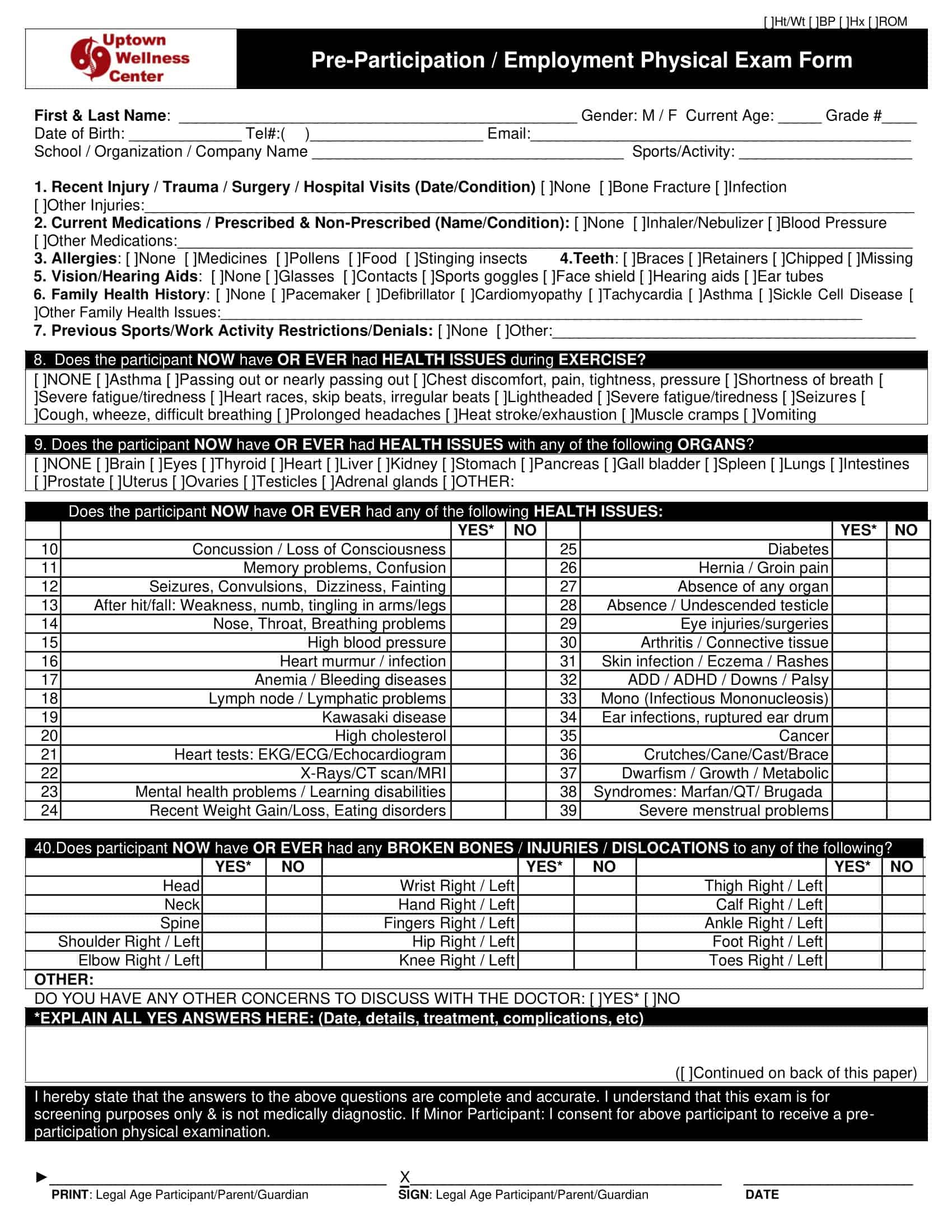




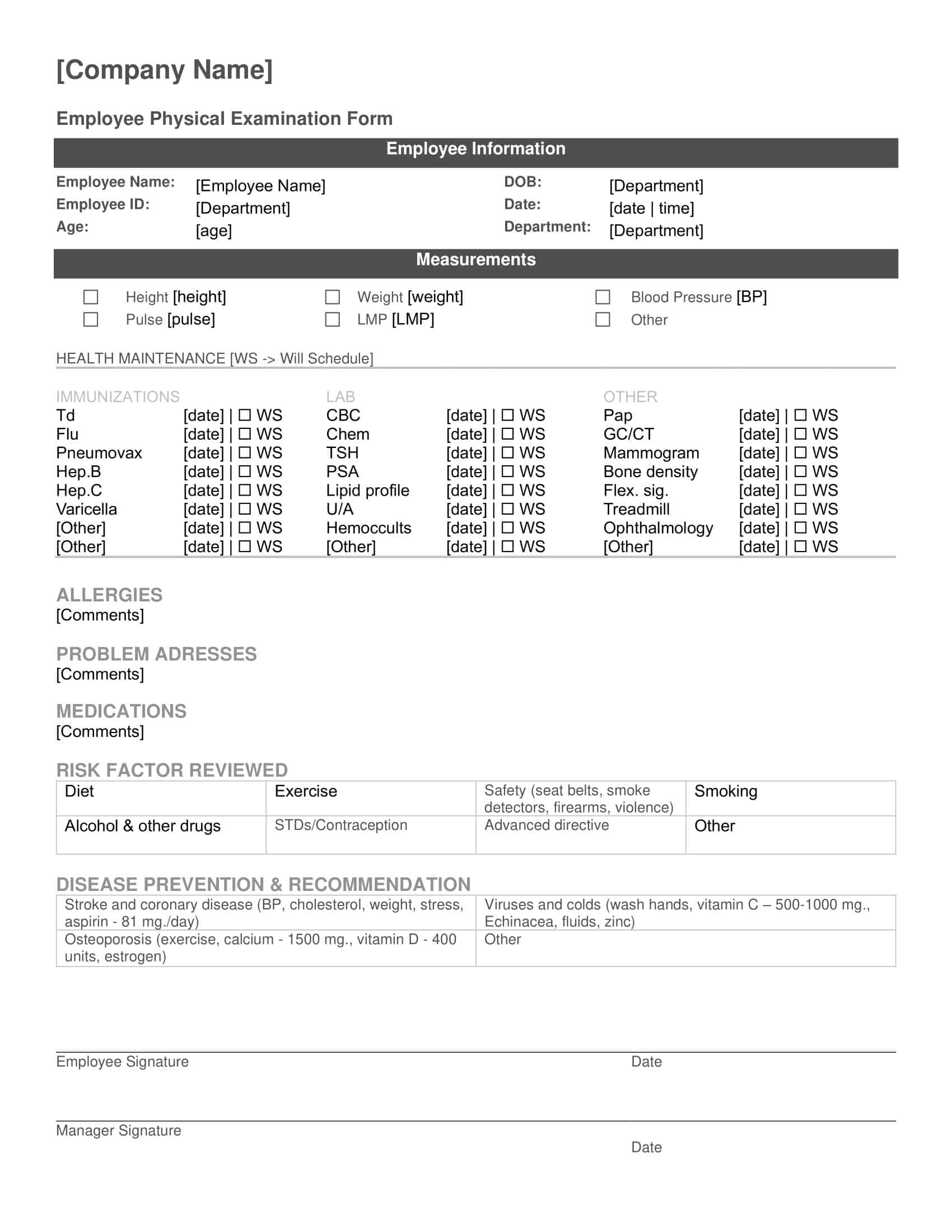





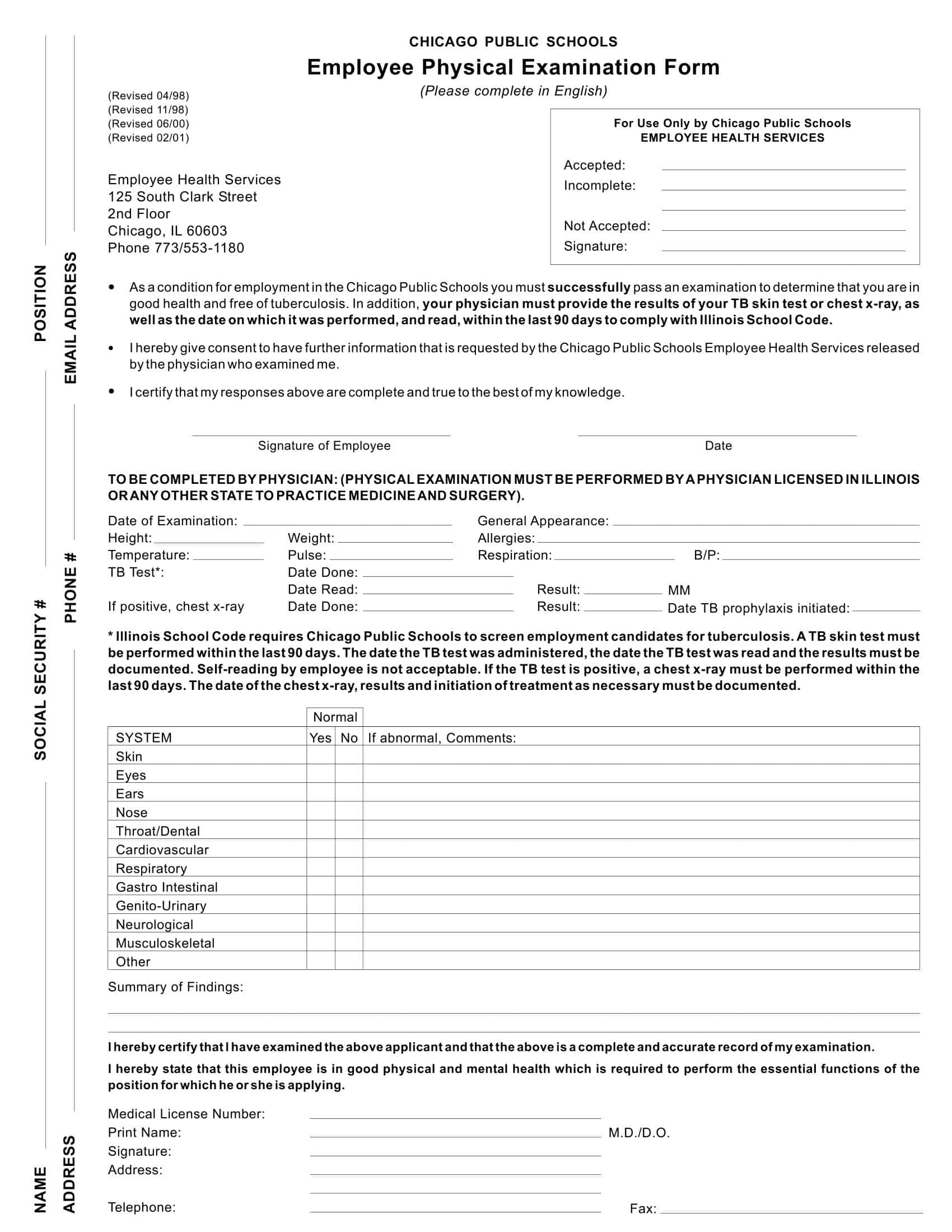
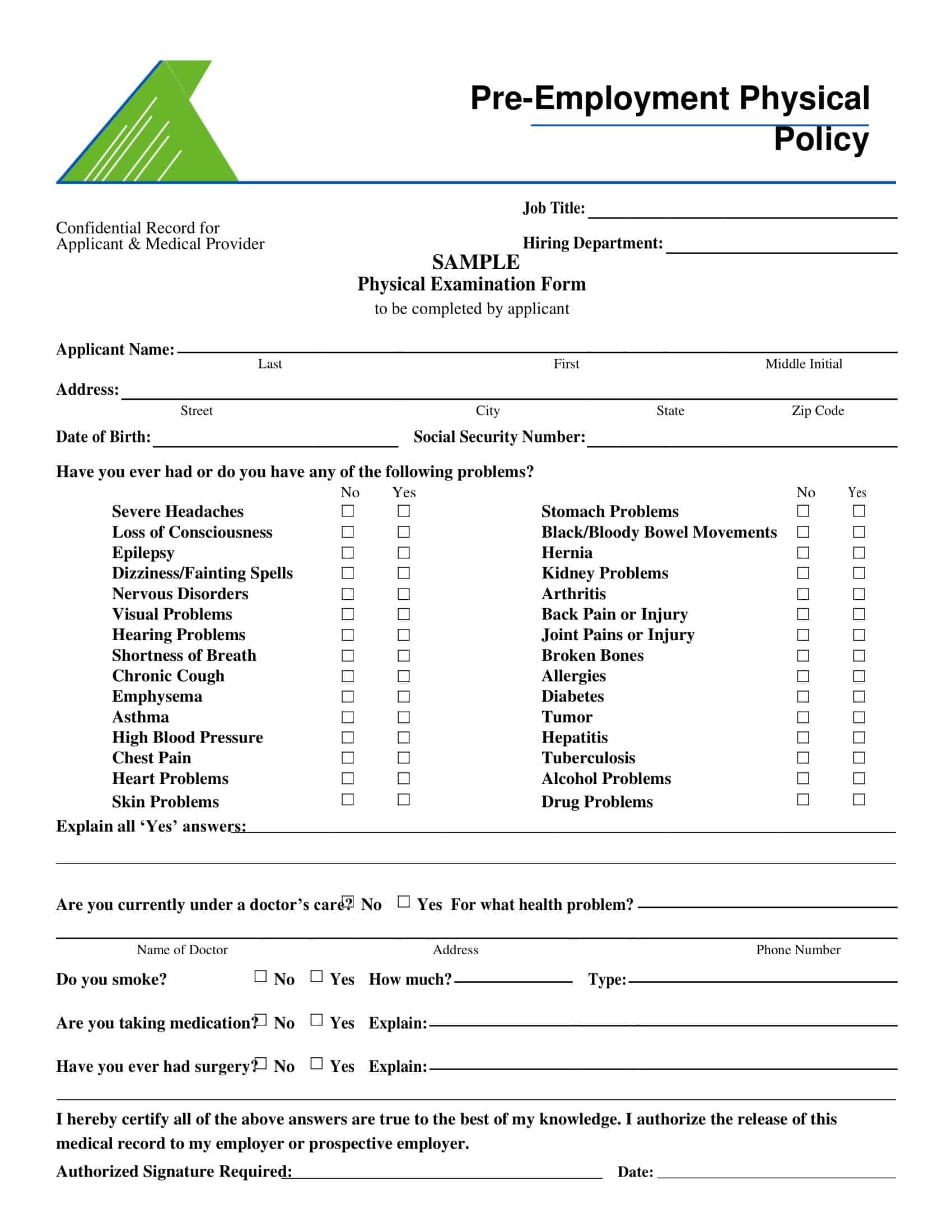








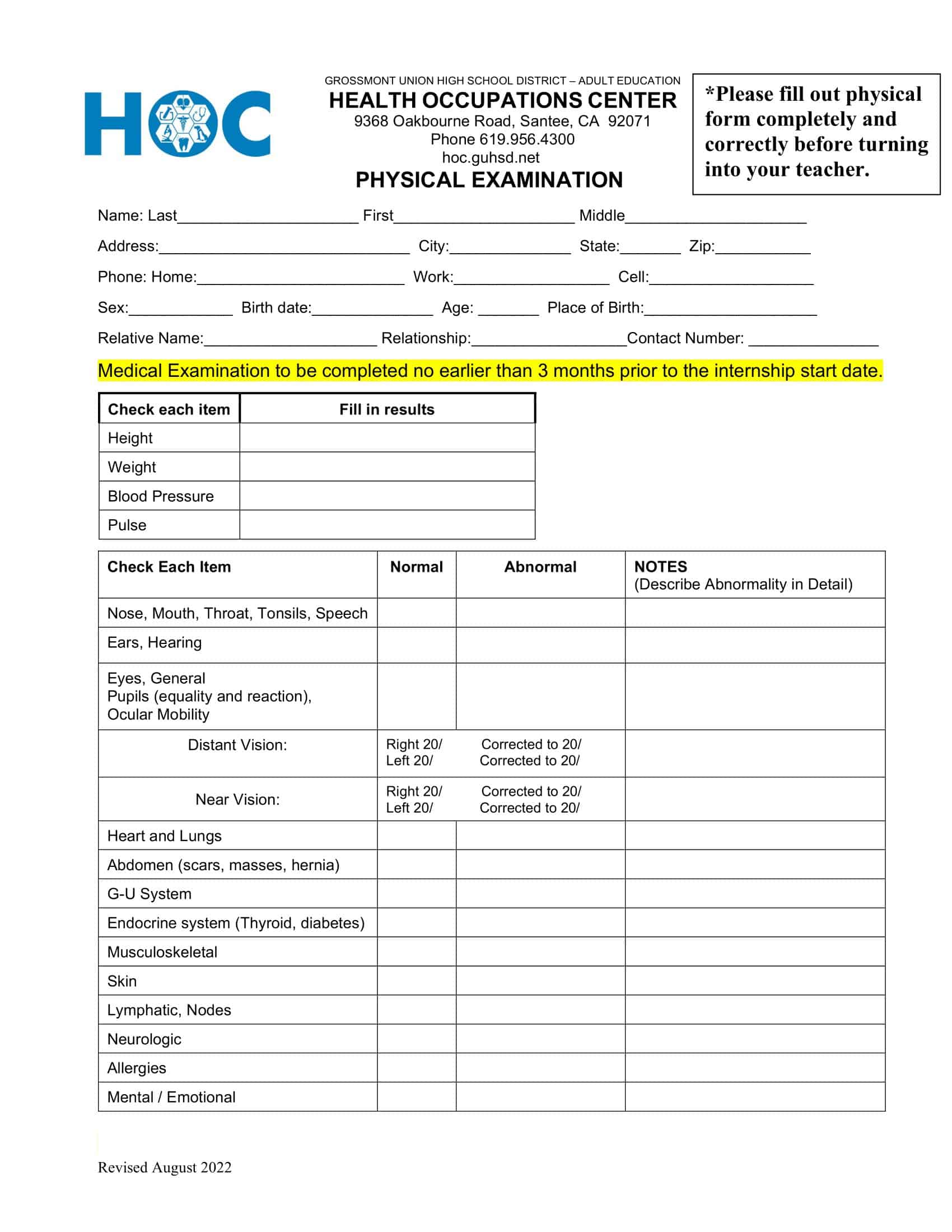











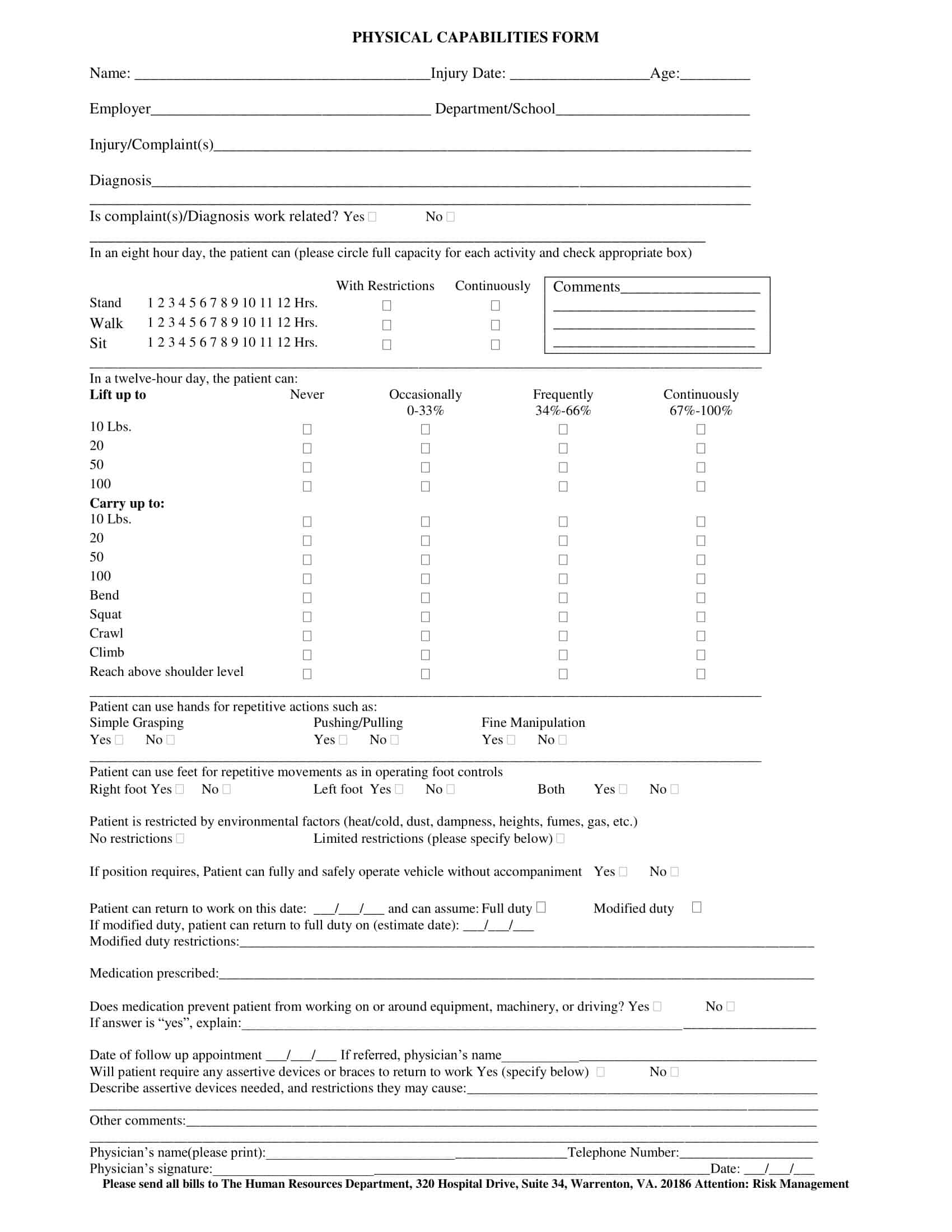

![%100 Free Hoodie Templates [Printable] +PDF 1 Hoodie Template](https://www.typecalendar.com/wp-content/uploads/2023/05/Hoodie-Template-1-150x150.jpg)
![Free Printable Food Diary Templates [Word, Excel, PDF] 2 Food Diary](https://www.typecalendar.com/wp-content/uploads/2023/05/Food-Diary-1-150x150.jpg 150w, https://www.typecalendar.com/wp-content/uploads/2023/05/Food-Diary-1-1200x1200.jpg 1200w)
![Free Printable Roommate Agreement Templates [Word, PDF] 3 Roommate Agreement](https://www.typecalendar.com/wp-content/uploads/2023/06/Roommate-Agreement-150x150.jpg)
